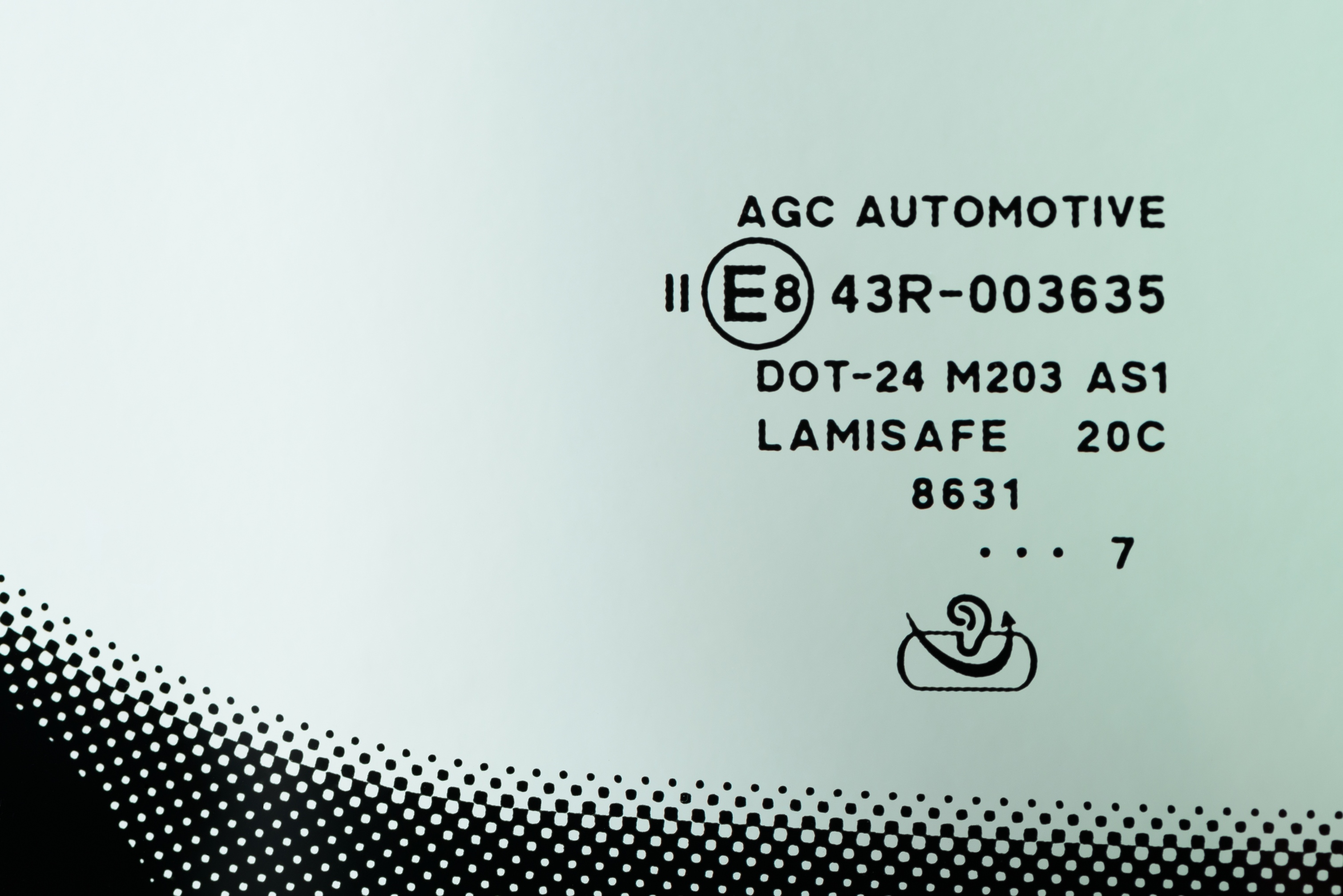Automotive glass marking
For the European market, two systems for vehicle homologation co-exist:
- European Union (EU) directives. This allows manufacturers to have a vehicle type approved in one Member State and then be able to market the vehicle in all other Member States without further tests.
- United Nations Economic Commission for Europe (ECE) regulations.ECE is an organisational part of the UN. Members include EU Member States as well as many other countries such as Japan, South Africa, Russia, Belarus, Turkey. Thus, testing according to ECE rules opens the door to global markets because of a wider acceptance of approved components.
All automotive glass has a stamp that can be used to identify the manufacturer and other details. The exact stamp and the contents vary depending on the manufacturer and the specific glass.
For example, AGC:

AGC AUTOMOTIVE: manufacturer’s brand
II : product type – ordinary laminated glass
(I: toughened glass; III: treated laminated glass in case of which at least one of the layers of glass has been specially treated to increase its mechanical strength; IV: glass-plastics; V: glass panes with less than 70% light transmittance; VI: double-glazed with less than 70% light transmittance; VII: for slow-moving vehicles which, by construction, cannot exceed 40 km/h; VIII: rigid plastic glazing that does not deflect vertically more than 50 mm; IX: flexible-plastic glazing, deflects vertically more than 50 mm; X: rigid plastic multiple-glazed unit; XI: laminated-glass panes, except windscreens)
E8 43R-003635: European standard ECE approved in the Czech Republic, type-approval.
(other country codes: E1-Germany, E2-France, E3-Italy, E4-Netherlands, E5-Sweden, E6-Belgium, E7-Hungary, E9-Spain, E10-Serbia and Montenegro, E11-United Kingdom, E12-Austria, E13-Luxembourg, E14-Switzerland, E16-Norway, E17-Finland, E18-Denmark, E19-Romania, E20-Poland, E21-Portugal, E22-Russia, E23-Greece, E24-Ireland, E25-Croatia, E26-Slovenia, E27-Slovakia, E28-Belarus, E29-Estonia, E31-Bosnia and Herzegovina, E32-Latvia, E37-Turkey, E39-Azerbaijan, E40-Former Yugoslav Republic of Macedonia, E42-European Community, E43-Japan, E45-Australia, E46-Ukraine, E47-South Africa, E48-New Zealand, E49-Cyprus, E51 Republic of Korea, E52-Malaysia, E53-Thailand.)
DOT-24: Splintex Belge S.A. Gilly, Belgium. DOT means Department of Transportation and shows the manufacturer.
M203: A unique number for each manufacturer that identifies the manufacture technology, glass structure, shade, thickness. The first two digits represent the thickness of the glass and the last digit represents the tone of the glass: clear glass – MXX0; green glass – MXX1; bronze glass – MXX2; blue glass – MXX3.
AS1: USA standard or AS-American Standard (ANSI-Z26.1) approved laminated windscreens and side and rear windows with at least 70% light transmittance;
(AS2: all tinted glass with a minimum of 70% transparency, except windscreens; AS3: non-windscreens with a light transmittance of less than 70%)
LAMISAFE: glass brand (Temperlite; Lamipane, etc.)
8631: the first four digits of a eurocode with up to 15 digits for the glass (8631 = Audi A4 2015).
. . . 7: Date of manufacture April 2007.
(There is no common regulation, therefore different markings are used. Since glass manufacturers are not interested in accurately informing the end-users about when the glass was manufactured, then those markings are hard to read. Some common variants:
- The last digit marks the manufacture year and up to 6 points before or after mark the manufacture month, e.g. October 2016 = 15 . . . .
- The 12 points that mark the month of manufacture are located before the manufacture year, so . 7 is December 2007 or . . . . . . . . . . . . 7 is January 2017.
- sometimes manufacture year is shown below or above the dots, etc.)
Pictogram: Acoustic glass. In addition, there may be: Thermal Comfort; Electrochromic; UV filter; Heatable; Antireflective; Safety; Antenna; Security; Hydrophobic etc.


